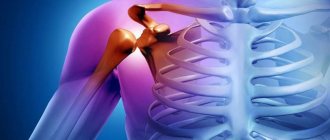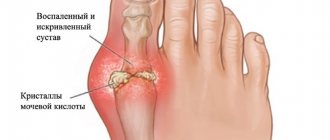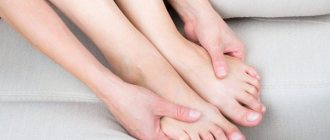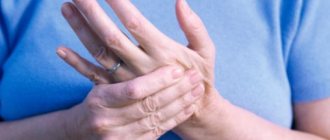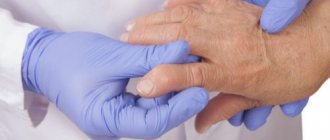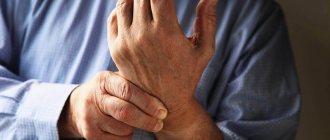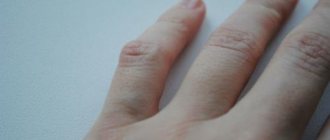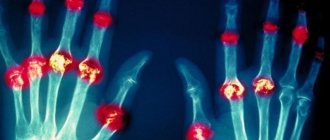- Flexion contracture of the fingers
- Treatment of finger contacts
- Exercise therapy for finger contractures
Contracture of the fingers is a position of the hand in which shortening of the tendons of the palmar surface occurs.
Over time, cicatricial degeneration is observed, and in this case the hand loses its motor function. The process itself is painless, but when you try to move the affected joints, severe pain develops. Some neurohumoral characteristics of the body contribute to the fact that contracture of the fingers predominantly develops in middle-aged men. The causes of the development of the pathological process: from systemic connective tissue diseases (Dupuytren's contracture) to traumatic lesions of the hand.
The pathogenesis of the development of contracture is that, under the influence of various reasons, afferent impulses in the nerve endings of the hand are transformed, as a result of which cords, nodules and scars begin to form. There is a shortening of the palmar fascia and thickening of the lower parts of the finger joints.
As the disease progresses, contracture of the fingers begins with the metacarpophalangeal joints, then the interphalangeal joints are affected. As a result, a dense cord stretches from the beginning of the palm to the fingers, limiting the movement of the hand.
Types of contractures
The classification of contractures affects several aspects at once. There are 2 main types of contractures in the joints of the fingers, which in turn are divided into several subtypes:
- Passive – occur against the background of damage to the joint itself or surrounding tissues.
- Arthrogenic, associated with changes in the joint, are observed in arthritis, osteoarthritis;
- Dermatogenous occur when the skin over the joint tightens due to a burn or extensive suppuration;
- Desmogenic are caused by scars in the connective tissue;
- Tendogenic ones are caused by shortening of the tendons of the fingers;
- Myogenic contractures are characteristic of pathology of the muscles surrounding the joint;
- Immobilization symptoms appear after prolonged fixation of the arm in a forced position;
- Ischemic ones are formed due to a prolonged decrease in blood flow in the hand, for example, due to a fracture.
- Active – neurogenic contractures that appear as a result of pathology of the central and peripheral nervous system. In this case, the tone of the flexor or extensor muscles changes, the fingers acquire a forced position.
- Central ones are observed in patients with stroke, traumatic brain injury, encephalitis, and cerebral palsy.
- Peripheral ones occur when there is mechanical damage to the nerve, its inflammation, or severe pain syndrome that limits the mobility of the fingers.
Peculiarities!
Active contractures are accompanied by hysterical contractures, in which the structure of the nervous tissue does not change, but due to mental disorders, a pathological persistent contraction of certain muscle groups is formed.
Extensor and flexion types of pathology
The form of contractures can be flexion, in which the dorsal extension of the fingers is difficult, and extension, when the fingers are in a straightened state, and it is not possible to bend them completely.
Somewhat less common in the hand are abduction contractures, when the fingers are difficult to connect with neighboring ones, and adductor contractures, in which abduction is difficult.
Contractures may be functionally advantageous or disadvantageous. In the first case, the function of the hand as a whole does not suffer, in the second, everyday and professional activities become difficult.
Other interventions
Despite the fact that surgery is considered the main treatment for Dupuytren's disease, not all patients are ready to undergo it. On the other hand, it is also the case that some patients who choose surgery may be considered unsuitable candidates due to comorbidities, age, frailty, or lack of social support and assistance needed after surgery.
This is why numerous non-surgical treatments for Dupuytren's disease have been developed, including high-pressure oxygen, ionizing radiation, ultrasound therapy, vitamin E and interferon, physical therapy, steroid injections and splinting. However, none of the listed methods alone can compare in effectiveness with surgery.
Currently, a number of studies demonstrate the clinical safety and effectiveness of Clostridium histolyticum collagenase injections. This drug is considered a promising new alternative to surgical treatment of Dupuytren's disease. Researchers believe that abnormal increases in collagen synthesis and deposition contribute to the formation of fibrous tissue and contractures in Dupuytren's disease. Clostridium histolyticum collagenase injections have been shown to be effective in targeting excessive collagen deposition and fibrous band tears that cause contracture of the metacarpophalangeal joints and proximal interphalangeal joints.
A large, prospective, multicenter, phase III clinical trial published in The New England Journal of Medicine in September 2009 confirmed the effectiveness of Clostridium histolyticum collagenase injection in reducing finger flexion contractures. In this study, 308 people with Dupuytren's disease were randomized in a 2:1 ratio. Participants received up to three injections into the cord area, 30 days apart. In one case, patients were administered 0.58 mg of Clostridium histolyticum collagenase; in another case, a placebo drug was administered. Thirty days after the last injection, 64% of participants who received collagenase had decreased joint contracture within 0-5 degrees of full extension. In the placebo group, contracture decreased in only 6.8% of participants. However, the proportion of patients experiencing side effects was higher in the collagenase group (97%), compared with 21% in the placebo group. Side effects reported during the study were mostly mild. These include enlarged lymph nodes, increased sensitivity, bruising, bleeding, itching, swelling or pain in the injection area. Three serious side effects were of greatest concern: two tendon ruptures and one case of complex regional pain syndrome, a progressive disorder that involves pain, swelling and skin changes. Further studies are needed to determine the long-term benefit and contracture recurrence rates of Clostridium histolyticum collagenase.
Before and after injection of Clostridium histolyticum collagenase
Causes
Most often, contractures develop under the following conditions:
- Consequences of joint injuries;
- Degenerative and inflammatory diseases of the musculoskeletal system;
- Diseases of the brain and spinal cord;
- Damage or other pathology of the peripheral nerve;
- Massive blood loss from the arteries of the arm;
- Extensive burns to the hand;
- Consequences of a purulent process in the soft tissues of the hand;
- Congenital developmental anomalies;
- Prolonged wearing of plaster or other fixation structures.
Information!
It is not always possible to accurately determine the cause of contracture or its connection with a specific disease. For example, the causes of Dupuytren's contracture, in which the ring and little fingers are pulled towards the palm, have not yet been established. Although it is known that the leading role in this case is played by the hereditary factor.
Mechanism of injury/Pathological process
The exact etiology of Dupuytren's disease is unknown, but researchers have identified a number of risk factors. Most often, the disease is found in representatives of the white Caucasian race in Northern Europe. On average, the disease occurs at 60 years of age, and the incidence rate increases with age. More often the disease affects men, but in older age the gender boundary is erased.
Twin and family studies indicate that Dupuytren's disease has a strong genetic component. Thus, members of families where the disease has already occurred may have more severe forms of contracture or may experience it at an earlier age. Studies of the prevalence and phenotype of the disease in different ethnic populations also indicate geographic association and genetic predisposition.
Numerous suggestions have been made about the influence of external factors on the development of the disease. However, some of them are very contradictory. Suspected environmental risk factors include alcohol consumption, smoking, manual labor or exposure to vibrations, elevated blood glucose levels, low body weight, low body mass index, and use of anticonvulsants. Dupuytren's disease is often accompanied by a number of other diseases, including epilepsy, diabetes mellitus, HIV, glenohumeral periarthritis and cancer.
Risk factors for Dupuytren's disease
Symptoms
Symptoms and diagnosis of the disease depend on its cause and form. The most common signs:
- Difficulty moving fingers;
- The appearance of pain when trying to move a finger;
- Tightness of the skin over the affected area;
- The presence of pathological formations under the skin in the projection of the joint damaged by the disease or next to it;
- Atrophy of the hand muscles;
- Impaired hand grip, loss of some household and professional skills.
Important!
The appearance of these symptoms is a serious reason to visit a doctor. Depending on the cause that caused them, contractures are treated by orthopedic traumatologists, neurologists, rheumatologists, surgeons, and psychiatrists.
Diagnostics
At the appointment, the doctor examines the injured arm:
- Notes the presence of space-occupying formations;
- Assess the condition of the skin;
- Palpates the fingers and palm to identify areas of tenderness and assess sensitivity;
- Determines the degree of flexion, extension, abduction and adduction of the fingers;
- Evaluates the volume of active and passive movements in the hand.
Be sure to inform your doctor about previous injuries, surgeries, joint and neurological diseases. Try to remember whether similar changes were observed in blood relatives.
To clarify the diagnosis, the following procedures may be prescribed:
- X-ray, MRI or CT scan of the joint;
- EMG – electromyography of the upper limbs;
- MRI or MSCT of the brain;
- General and biochemical blood test (determination of rheumatoid factor, C-reactive protein, etc.).
Treatment
Conservative or surgical treatment of contractures is carried out. Treatment without surgery is possible if the pathological process is of minor severity and short duration. In this case, exercise therapy, physiotherapy, hormone therapy, skeletal traction, and medical blockades are prescribed.
If the above measures are ineffective, surgical treatment of contracture is resorted to. Taking into account the cause of the disease, excision of the scar, dissection of the connective tissue layer - aponeurosis, joint capsule or tendon, and plastic surgery of the joint are performed. In advanced cases, the only option left is arthrodesis - closing the joint in a more comfortable position for the person. In this case, mobility is completely lost, but many skills can be preserved.
Note!
Surgical treatment is resorted to only as a last resort, since hand function after open surgery is restored only after a few months, and the risk of relapse remains high.
Exercise therapy complex for finger contractures
Therapeutic gymnastics is a method of conservative therapy designed to restore mobility of the fingers and slow the progression of the disease. We offer you the most effective exercises for relieving muscle tension and stretching the palmar aponeurosis. They should be repeated several (at least two) times a day, 10 times each.
- Place your forearms on the table, palms down. Make a fist with your fingers, sliding them along the tabletop.
- Spread your fingers as far apart as possible.
- Roll a pencil or pen across the table with your palms.
- Roll a small ball (such as a tennis ball) in a similar circular motion.
- Imitate playing the piano by tapping the table with your fingertips.
- Raise your fingers above the horizontal surface without lifting your palm from it.
- Turn your hands with your palms facing up. With quick movements, clench and unclench your fists so that your thumb is either on top or inside your palm.
- Leaving your fingers clenched, touch your thumb to all the others one by one, starting with your little finger.
- Alternately connect the pads of all fingers with the thumb.
- Consistently make “clicks” in the air with all your fingers.
- Bend and extend your fingers so that the healthy hand provides resistance to the injured one.
The listed exercises are performed not only with a sore hand, but also with a healthy hand. To increase the elasticity of the skin before exercise, lubricate it with a softening cream.
Advice!
It is considered more effective to treat the disease using not ordinary cosmetic creams, but special ointments and gels with fibrinolytics - substances that loosen connective tissue.
Prevention
Remember that surgery and complications can be avoided by preventing contractures.
- Do not cause diseases of the joints and surrounding tissues; consult a doctor in a timely manner.
- If, due to your professional activities, you have to load your hand, then do relaxation exercises and massage during breaks.
- Do not neglect exercise therapy after injuries or strokes.
- Use nourishing creams regularly.
- Eliminate bad habits: excessive drinking, smoking.
- In your free time, engage in a useful hobby that develops fine motor skills: embroidery, beadwork, clay modeling, assembling models from small parts.
Therapeutic exercises are the main method of treatment and prevention for Dupuytren's contracture, as well as for contractures due to stroke or joint injury. Systematicity and regularity of exercises are especially important so that the return of normal mobility to the fingers occurs gradually.
Cost of Dupuytren's contracture
You can have the operation in our clinic in St. Petersburg. The cost of treatment for Dupuytren's contracture depends on many factors, including the individual characteristics of the patient, the stage of the disease, and symptoms that have already appeared. Therapy at the first stage is cheaper, faster, and does not require a long stay in the clinic. In most cases, surgery leads to a complete recovery.
Treatment of stage 3 and 4 Dupuytren's contracture in St. Petersburg will be more expensive and will not completely eliminate the deformity of the affected fingers. The sooner surgical intervention is performed for pathology, the higher the patient’s chances of regaining mobility of the fingers and hand.
If you are calculating the cost of treatment for Dupuytren's contracture, keep in mind that the final amount will consist of the following components:
- preliminary examination by specialists, examinations and tests, additional studies, if necessary;
- additional consultations with doctors of various profiles;
- operation;
- cost of drugs;
- procedures necessary for rehabilitation;
- cost of staying in the clinic.
